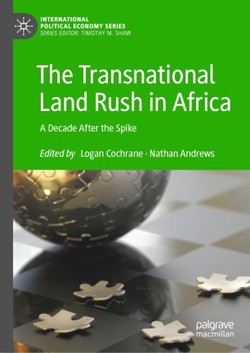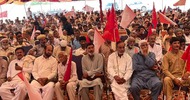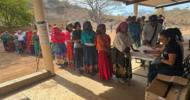Afronomics Law | 18 November 2021
An appraisal of promises after the ruins: The global land rush in Africa
An appraisal of promises after the ruins: The global land rush in Africa
By Kariuki Kirigia
Following the global financial crisis of 2007-08, which overlapped with a global food security crisis, the global land rush emerged as a key phenomenon that has since become the metonymic expression of the global response to these crises. Cochrane’s and Andrews’ The Transnational Land Rush in Africa: A Decade After the Spike provides a timely and necessary update of the land rush “a decade after the 2007/08 commodity price spike.” The book addresses some of the major misconceptions about the land rush on the African continent and, especially, the Eurocentric coverage of the land rush in Africa within the international political economy discourse by attending to local, national, and transnational land grabs and actors that have been largely marginalized in these debates. The book embarks on a comparative undertaking whereby each chapter focuses on “an overview of country trends, the relevant governance structures (regulation, land tenure, and policy and law), and a discussion of the impacts of land acquisitions on livelihoods and resulting inequalities” (p.7). The editors note that the macro-level analysis of the book, while facilitating a broad geographical coverage, is also its main limitation, and suggest qualitative research carried out at micro-scales that arguably provides nuances and detailed descriptions of the land rush in the African context as a cogent way of shining the light into the blurry crevices of land grabbing on the continent.
The first of three parts of the book, “The Land-Development Nexus: Grand Discourses, Social Injustice and Contestations,” comprises four chapters which form the crux of my review of the book. Hamann’s and Sneyd’s chapter, “Agri-Business Development in Cameroon: Colonial Legacies and Recent Tensions,” discusses the nature of the land rush in Cameroon, a uniquely different setting from many discussions about the global land rush in Africa and the Global South writ large in that, rather than constituting a new wave, it represents continuity of land grabbing steeped in the country’s complex colonial history. The authors identify three key waves in which land grabbing has occurred in the country: (i) colonial plantations established in the late 1800s under the German colonial rule which were later pursued by the French and the British following Germany’s defeat in WWI, (ii) state acquisitions through nationalization of colonial plantations and expansion of the agro-industrial sector soon after the post-independence unification of the Anglo- and Francophone Cameroon, and (iii) the adoption of neoliberal policies starting in the early 2000s.
Following this background, the authors observe that land rush in Cameroon was not simply in response to the global dynamics precipitated by the 2007-8 financial and food security crises, but, rather, these factors added fuel to the flames. Further, ineffective regulation fed conflict over land and, domestic actors, as opposed to foreign actors, are at the centre of land grabbing in Cameroon. At the same time, the policies being fashioned in the country, such as the Cameroon Vision 2035, are largely informed by neoliberal precepts that favour foreign investors while Cameroonians constitute a necessary labour pool postulated to benefit from employment. On the contrary, it has been established that efficiency in agriculture usually results in reduced human labour requirements, thus rendering employment a neoliberal promissory note that Igoe and Brockington remark is often is never realized. These acquisitions have targeted the fertile lands in the country, or those landscapes endowed with mineral resources, a trend that rings true to James Ferguson’s observation that capital investments hop onto areas of high potential while “neatly skipping over most of what lies in between” (p. 38). The authors challenge the overemphasis on land in the land-grab debates and caution that investors often extract other resources, sometimes illegally, from the land in addition to engaging in agricultural production, and they term this as the hyper-exploitation of local resources. Although the chapter mentions local mobilization as instrumental in pushing back against land grabbing, there is no detailed account of the nature of these modes of mobilization.
In Chapter 3, Marie Gagné and Ashley Fent, akin to the second chapter, underline political continuity by bringing our attention to the potential of regime change to alter the course of land-based investments within Senegal and, in so doing, recentre the African state in the land rush debates. While the Senegalese government identified agriculture and mining as the two key sectors for fostering the country’s economic growth, and adopted policies focused on attracting foreign investments to bolster an export-based economic model, the imagined returns were not realized. The authors delve into how these seemingly well-intentioned schemes went awry, to borrow from James Scott, and identify three key explanatory factors: “(1) the effectiveness of social resistance to land investments, (2) the contradictory behaviour and motivations of the Senegalese state, and (3) the managerial deficiencies of companies in charge of these projects” (p.56). Again, similar to Cameroon, large-scale land deals in Senegal are not new, having begun during the French colonial period. Many land deals were sanctioned during President Wade’s regime, but during Sall’s presidency, land deals have diminished, despite both leaders adopting similar approaches to economic development. A key gap that facilitates land deals at the cost of alienating local communities is the refusal by the Senegalese state to “recognize traditional land rights that are unregistered with the state” (p.63). Even then, local communities have resisted land deals in numerous ways that include destruction of property and fences, forceful occupation, and through local courts. The success of these reactions from below has depended upon the timing of local mobilization and type of investment being targeted, with relative success being realized when projects are in the formative stages, and among agricultural than mining projects. Local resistance, however, has been derailed by first, the complex configuration of the investment entities that complicates access to information about the investors and, second, by conspiratorial state personnel who often discredit such resistance. Given the extensive variegation and complexity of land deals in Senegal, the authors suggest that the manner of categorization in key databases such as the Land Matrix is less based on logic than convenience, and that further work in terms of data collection and recording remains for comprehensive characterization of land deals to be accomplished.
In Chapter 4, Patrick Wight’s “Epilogues of a Short-Lived Land Rush: Private, Rural, and Urban Land Tenure in South Sudan” details how local communities, often viewed as the owners of the land, are bypassed by capital investments especially in conflict zones, whereby state officials and warlords enter into agreements with investors culminating in what the author terms as high-risk high-reward arrangements. Following a protracted civil war in South Sudan, conflict has overdetermined the landscape of foreign investments, tenure security, and land policy. While foreign investors showed enthusiasm in pursuing land deals in South Sudan with the expectation of an end to the conflict, the breakout of a civil war in 2013 thwarted land-based investments and, in the few cases where deals were brokered, were marred with opportunistic politico-warlord personnel who excluded local communities on the land earmarked for acquisition. For the foreign investments trickling in and the push for large-scale agricultural production for domestic and export markets, customary tenure that is prevalent in the rural areas is seen as inhibitive to investments in land. Owing to the civil conflict, however, land-centric politics are dominated by the quest for land by formerly displaced communities who seek to return on their land, but where such return is complicated by other groups settling on the same land coupled with local leadership favouring some ethnic groups over others. The prominence of local leadership in land politics brings into focus the stratified nature of power among local communities which underlines how politics on the ground influence security of tenure and access to land and resources. While this chapter provides important insights, it would enrich future work to bring in the voices of local communities especially in the rural areas where customary land tenure is targeted for formalization and commodification.
The fifth chapter by Noah Echa Attah, “Behind Accumulation and Dispossession: State and Large-Scale Agricultural Land Investments in Nigeria,” evaluates the impact of state-sanctioned land deals on the “land rights and livelihoods of rural people. Furthermore, it [the chapter] identifies the political and economic forces responsible for reconfiguring land use patterns and ownership rights in Nigeria, in continuing processes of private accumulation through large-scale investments in land” (p.115). In a country burdened with imports of agricultural products and ranked 93rd out of 117 on the Global Hunger Index, the government presents foreign land-based investments as a compelling strategy for addressing the agricultural product gap. The author makes an important distinction between small-scale, local, corrupt land deals from land grabbing wherein the latter refers to the large-scale, transnational acquisition of land for export crops and mineral resources. With this distinction, the author arguably exposes the rhetoric of land grabbing in that rather than supporting the growth of the host countries’ economies and attaining the promise of sustainable development, the products are usually for export and “empirical evidence suggests that agro-industrial investments are exacerbating food crises, environmental degradation, and rights violations in affected communities” (p.116).
The push for foreign investors is underpinned by arguments that there is abundant land in the country. However, Attah cautions against such perceptions since the said land is often under cultivation by local communities whose rights remain unrecognized by the state. Attah further disapproves of rapacious leaders who broker land deals motivated by “promises of job opportunities, improved facilities, and compensation” (p.115). The author demonstrates how even state laws meant to protect the citizenry are subverted to serve the interests of elites and foreign investors. In reference to the 1978 Land Use Act, he notes that while it was meant to protect the land for the benefit of the Nigerian citizenry, “the Act shifted the balance of rights against autochthonous owners by terminating usufructuary rights to ancestral lands and vesting them in the state, which can exercise its right of eminent domain” (p.121). The author illustrates the subversion of the Act with a discussion of three key foreign investments: Zimbabwean commercial farmers, WILMAR International, and the Dominion Farms. In an interesting turn of events, the Zimbabwean farmers, rather than channelling in capital into Nigeria, were provided soft loans and financial support by the Kwara State government, on which they defaulted. Instead of bringing the imagined agricultural revolution touted by politicians, the investors only ended up appropriating public resources thereby burdening the citizenry who, in theory, should have reaped the fruits of the investments. The other two investments only acquired huge tracts of land after the evasion of local communities cultivating the land.
These country case studies illustrate the complex intertwinement of local communities, the state, and foreign investors in land grabbing. While local communities often find themselves on the losing end of land deals despite promises of employment, foreign investors acquire huge tracts of land under highly favourable terms built on the rhetoric of sustainable development, job creation, or addressing local food insecurity. The African state appears to function through what Achille Mbembe calls private-indirect governance in that state officials act not in the interest of the citizenry, but, rather, in line with personal interests constitutive of monetary benefits and political leverage, as shown by Attah in the case of Nigeria and in Senegal by Gagné and Fent. That reactions from below have thwarted oppressive land acquisitions in Senegal, sometimes with the support of state officials, both underlines the resourcefulness of local mobilization and the African state apparatus in fighting against the expansion of primitive capitalistic expansion on the African frontier. To further scholarly work on land grabbing in Africa, the authors underscore the pressing need for accurate and detailed data collection.














